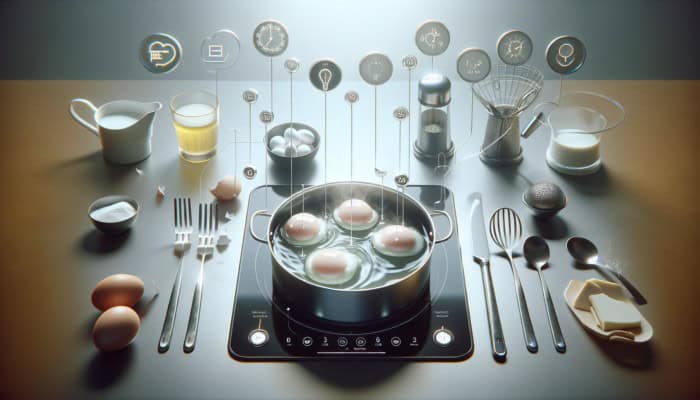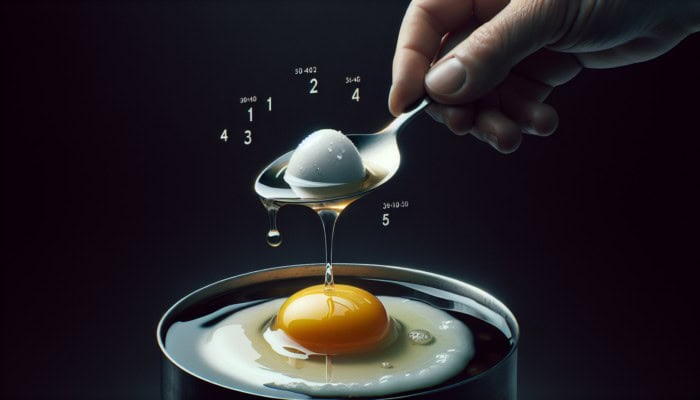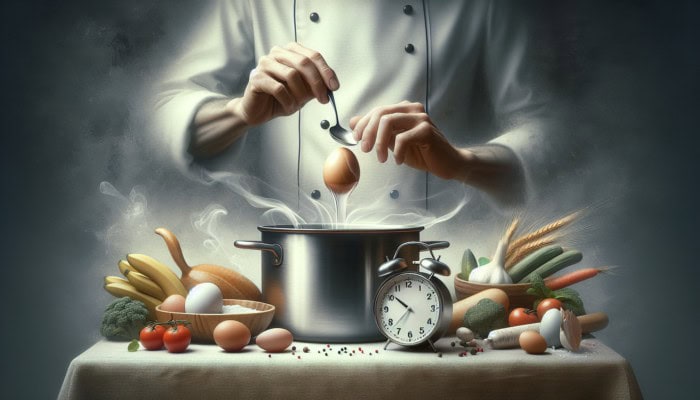Master the Art of Poaching Eggs: Your Comprehensive Guide to Perfect Results Every Time
Few culinary skills are as fulfilling as mastering the technique of poaching eggs. Achieving the perfect balance of heat and timing can transform basic ingredients into an impressive culinary delight. To fully grasp how to poach an egg perfectly every time, it's crucial to understand the essential elements contributing to your poaching success. This guide will explore these key factors in detail, ensuring you have the knowledge to create consistently delicious results.
Selecting High-Quality Eggs: The Foundation of Your Poached Eggs

The journey toward a sublime poached egg starts at your local grocery store or farmers' market. It's important to recognize that not all eggs are created equal; the freshness and quality of your eggs significantly impact the final dish. Fresh eggs possess tighter whites that maintain their shape during cooking. When you crack open a fresh egg, you'll observe that the yolk sits higher, with firmer, less runny whites. This firmness is precisely what you need for a stunning poached egg that holds its shape beautifully in the water.
When choosing eggs, prioritize those with clean, uncracked shells and opt for a ‘best before' date well into the future. If possible, buy from local farms or reputable suppliers known for their high egg quality. Organic and free-range eggs are usually fresher, as these hens are raised in better conditions, leading to richer yolks and superior flavors.
In summary, the initial step in mastering how to poach an egg perfectly every time is to select the best eggs available. This foundational choice sets the tone for success, ensuring that your poached eggs are visually appealing and bursting with flavor.
Achieving the Ideal Water Temperature: A Crucial Element for Poaching Success
Water temperature is a vital factor in the poaching process that can make or break your results. The optimal poaching temperature ranges from 80 to 90 degrees Celsius (176 to 194 degrees Fahrenheit). At this temperature, the water is hot enough to cook the egg gently without reaching a vigorous boil, which can create a chaotic cooking environment. Boiling water causes the egg whites to move too aggressively, leading to an unattractive appearance and uneven cooking.
To achieve the perfect water temperature, bring a pot of water to just below boiling. You should aim for a gentle simmer, with small bubbles visible at the bottom of the pot but not breaking the surface forcefully. A thermometer can aid in monitoring this, but with experience, you'll learn to recognize the right temperature through visual and auditory cues.
Once the correct temperature is reached, it's essential to maintain it throughout the cooking process. If the water cools, the egg will take longer and may not achieve that desirable silky texture. Conversely, if the water begins to boil, reduce the heat immediately. Mastering water temperature control is a critical skill in your quest for how to poach an egg perfectly every time.
Utilizing Vinegar: A Secret Ingredient for Perfect Egg Whites
Vinegar is often underestimated in the poaching process, yet it plays a pivotal role in ensuring the success of your eggs. The acidity of vinegar accelerates the coagulation of proteins in the egg whites, which helps the egg stay together and improves the overall texture. This is especially important for those utilizing slightly older eggs, as whites tend to be less cohesive than fresh eggs.
When incorporating vinegar into your poaching water, aim for approximately one tablespoon per litre. White vinegar is commonly used, but apple cider vinegar can provide a milder flavor if preferred. The key is to ensure the vinegar is evenly distributed in the water before adding your egg, as this prevents uneven clumping.
While vinegar does impart a slight flavor, when poached correctly, its taste should remain subtle and not overpower the egg's natural richness. Recognizing the function of vinegar is essential as you refine your technique for poaching an egg perfectly every time. This small addition can significantly enhance the quality of your poached eggs.
Step-by-Step Technique: A Detailed Guide to Poaching Eggs

Adopting a systematic approach is key to truly excelling at poaching eggs. With the right tools, techniques, and timing, you can consistently achieve that perfect poached egg. Let's outline a detailed step-by-step guide for this culinary journey.
Organizing Your Workspace: Essential Tools and Ingredients
Before beginning the poaching process, it is crucial to set up your workspace efficiently. Gather all necessary ingredients and tools, ensuring everything is within easy reach. To successfully poach eggs, you will require a pot, a slotted spoon, a timer, a bowl for cracking the eggs, and a thermometer for precise temperature monitoring.
Start by filling your pot with enough water to fully submerge the eggs and placing it on the stove. As discussed previously, bring the water to the desired temperature. While waiting for the water to heat, prepare your eggs by cracking them into individual bowls. This method simplifies adding eggs to the water and allows you to check for any shell fragments or bad eggs before they enter the pot.
Organizing your workspace streamlines the cooking process and minimizes the chance of mistakes. When you feel confident that everything is arranged properly, you're ready to proceed to the next step of the poaching process.
Employing the Swirling Water Method: Step-by-Step Instructions
The swirling water method is one of the most effective techniques for poaching eggs. This technique creates a gentle vortex, which helps to keep the egg together during cooking. Here's how to execute it:
First, once your water reaches the ideal temperature, gently stir it with a spoon to create a whirlpool effect. This motion aids in guiding the egg whites around the yolk, promoting cohesion and ensuring a more uniform shape. Next, take your bowl containing the cracked egg and gently slide it into the center of the vortex.
Be careful not to drop the egg from a height, which can cause the whites to break apart. Instead, allow the egg to glide smoothly into the water. As the egg cooks, you'll observe the whites wrapping around the yolk, forming that signature poached egg shape.
Sustain the gentle swirl for several seconds to help the egg set. The key is to gently move the water without escalating to a vigorous boil. Perfecting this approach is essential for those aspiring to master how to poach an egg perfectly every time, as it significantly enhances the final presentation.
Perfect Timing: How Long to Poach for Ideal Results

Timing plays a crucial role in achieving the perfect poached egg. The cooking duration may vary slightly based on the egg size and your preference for yolk consistency. Typically, you can expect to poach an egg for approximately 3 to 4 minutes for a runny yolk, while a firmer yolk may require up to 6 minutes.
To ensure consistency, start your timer when the egg enters the water. For those new to poaching, utilizing a timer is helpful to prevent overcooking. Once the time is up, gently lift the egg from the water using your slotted spoon and check for doneness. The whites should be set, while the yolk should still feel soft to the touch.
If you find yourself overcooking an egg occasionally, don't be discouraged. Use this experience to adjust your timing for future attempts. With practice, you'll develop an intuitive understanding of how long to poach for your desired level of doneness—an essential skill in how to poach an egg perfectly every time.
Removing and Draining: Techniques for Perfectly Shaped Eggs
After achieving your desired cooking results, the next challenge is to remove the eggs from the water without compromising their shape. This is where a slotted spoon becomes invaluable. Gently slide the spoon beneath the egg, ensuring you adequately support it as you lift it out of the water.
Once the egg is removed, draining excess water is crucial. To absorb moisture, place the egg on a plate lined with kitchen paper or a clean towel. This step is vital, especially if you plan to serve the eggs on toast or in a dish where excess moisture could lead to a soggy texture.
For an appealing presentation, consider trimming any uneven edges of the egg whites with kitchen scissors. This simple adjustment can make your dish delicious and visually stunning. By carefully removing and draining the eggs, you're well on your way to mastering how to poach an egg perfectly every time.
Avoiding Common Mistakes: Tips for Flawless Poached Eggs
Even experienced cooks can encounter common pitfalls when poaching eggs. Understanding these mistakes will enable you to consistently refine your technique and achieve exceptional results. Let's examine frequent errors and how to prevent them.
Overcooking: Identifying Signs and Solutions
Overcooking is one of the most prevalent mistakes when poaching eggs. If you've ever had a rubbery texture or a yolk reminiscent of a hard-boiled egg, you know the disappointment well. The secret to avoiding overcooking is closely monitoring your timing and water temperature.
To prevent overcooking your eggs, use a timer and check them a minute earlier than you expect them to be done. You can also gently poke the egg with a spoon—it should feel firm yet have a slight give if it's perfectly poached. If you often find your eggs overcooked, consider adjusting your heat settings or investing in a reliable kitchen timer.
Additionally, due to residual heat, eggs continue to cook slightly after being removed from the water. This is another reason to be cautious with your cooking times.
Egg Disintegration: Causes and Prevention Strategies
Another common problem is egg disintegration, where the whites disperse in the water instead of remaining cohesive. This issue can be particularly frustrating and often results from using older eggs or excessively hot water.
To prevent disintegration, always opt for the freshest eggs available. The tighter whites of fresh eggs will hold their shape better. Adding vinegar to the water can help tighten the whites if you must use older eggs.
Furthermore, ensure your water is at the right temperature before introducing the egg. If the water is too hot, it can cause the egg to break apart. Employ the swirling method to create a vortex, which helps keep the egg together during cooking. By being mindful of these factors, you'll minimize the risk of egg disintegration and enhance your skills in poaching an egg perfectly every time.
Achieving Even Cooking: Tips for Consistent Results
Uneven cooking occurs when heat isn't evenly distributed or insufficient water movement. If you notice that certain parts of the egg are overcooked while others remain runny, it's time to reassess your technique.
To combat uneven cooking, ensure your pot is large enough for proper water circulation. A smaller pot can lead to crowding, which may cause inconsistent cooking. Also, maintain a gentle simmer and ensure the water swells when adding the egg. This movement guarantees that heat is evenly distributed around the egg, producing more consistent results.
By mastering these common mistakes, you can build your confidence and refine your ability to produce perfect poached eggs, reinforcing your understanding of how to poach an egg perfectly every time.
Enhancing Your Poaching Skills: Innovative Tools and Gadgets
The right tools can significantly impact your results in the pursuit of culinary excellence. While traditional methods are effective, innovative gadgets can provide convenience and precision. Let's explore some of these tools and evaluate their worth for your poaching endeavors.
Egg Poachers: Evaluating Their Value
Egg poachers are popular kitchen tools designed specifically for cooking eggs gently. They usually consist of a pan with inserts that hold the eggs above simmering water, creating a controlled cooking environment. This method can be particularly beneficial for those new to poaching, as it simplifies the process and reduces the risk of mistakes.
However, while egg poachers may offer convenience, they might not provide the same level of control as traditional methods. The water temperature can fluctuate, and the eggs may not achieve that classic poached texture. An egg poacher can be an excellent way for beginners to build confidence. However, for those aiming to master how to poach an egg perfectly every time, it's advisable to learn the classic technique first.
Ultimately, whether to invest in an egg poacher depends on your cooking style and how frequently you intend to prepare poached eggs. It could be a valuable addition to your collection if you enjoy experimenting in the kitchen.
Silicone Cups: An Ideal Option for Beginners
Silicone cups have recently gained popularity as a practical solution for poaching eggs. These flexible cups can be placed directly into simmering water, allowing for even cooking without swirling. This method can be particularly advantageous for beginners who may find the swirling technique challenging.
To use silicone cups, grease them lightly to prevent sticking, crack an egg into each cup, and then place them in a pot of simmering water. Cover the pot with a lid to trap heat and steam, producing perfectly poached eggs. The silicone material ensures easy removal and minimal cleanup, making them an excellent choice for busy mornings.
While silicone cups may not replicate the traditional poaching experience, they are a fantastic tool for those learning how to poach an egg perfectly every time. They provide a forgiving method that can yield satisfying results without the stress of managing water temperature and swirling techniques.
Sous Vide: The Ultimate Precision Poaching Method
For those seeking the utmost cooking precision, the sous vide method offers a groundbreaking approach to poaching eggs. Sous vide involves vacuum-sealing food in a bag and cooking it in a water bath at a precisely controlled temperature. This technique enables you to poach eggs to your preferred level of doneness with minimal effort.
To sous vide poach eggs, set your immersion circulator to your desired temperature—typically around 63 degrees Celsius (145 degrees Fahrenheit) for a runny yolk. Place the eggs in their shells directly into the water bath and cook for about 45 minutes. The result is an egg cooked evenly throughout, boasting a silky texture that is challenging to achieve through traditional methods.
While sous vide machines can represent a significant investment, they are an impressive option for those passionate about cooking and eager to experiment with precision. If you're serious about perfecting how to poach an egg perfectly every time, this method can elevate your culinary skills.
Showcasing Your Skills: Recipes and Serving Suggestions for Poached Eggs
Having mastered the fundamentals of poaching eggs, it's time to flaunt your skills with some delicious recipes. Poached eggs are incredibly versatile and can elevate a variety of dishes. Let's explore some classic and modern serving suggestions that highlight the elegance of a perfectly poached egg.
Classic Eggs Benedict: A Timeless Culinary Delight
Eggs Benedict is perhaps the quintessential poached egg dish, combining rich flavors with elegant presentation. To prepare this classic, start with toasted English muffins and crispy bacon or smoked salmon. Place a perfectly poached egg on top, allowing the yolk to cascade over the other ingredients.
For the finishing touch, whip up a homemade hollandaise sauce by whisking egg yolks, lemon juice, and melted butter until smooth and creamy. Drizzle the hollandaise over the poached egg, and garnish with fresh herbs or a sprinkle of paprika for a vibrant pop of color. This dish showcases your poaching prowess and impresses at brunch gatherings.
Eggs Benedict is a timeless dish that celebrates the delicate flavors of poached eggs while offering a satisfying meal perfect for any occasion. By mastering this recipe, you'll be one step closer to understanding how to poach an egg perfectly every time.
Avocado Toast with Poached Eggs: A Modern Brunch Essential
Avocado toast has swiftly become a modern brunch staple, and adding a poached egg elevates it to new heights. To create this dish, start with a slice of artisanal bread, toasted to perfection. Mash ripe avocado with lemon juice, salt, and pepper, then spread it generously over the toast.
Top the avocado with a perfectly poached egg, allowing the yolk to break and mingle with the creamy avocado. Add toppings such as feta cheese, cherry tomatoes, or a sprinkle of dukkah for an extra flavour. This combination offers a delightful balance of textures and tastes while providing a nutritious meal.
Avocado toast with poached eggs is visually appealing and a fantastic way to incorporate healthy fats and protein into your diet. This dish exemplifies poached eggs' versatility and ability to enhance even the simplest of meals.
Poached Eggs in Soup: A Comforting and Luxurious Twist
Consider adding poached eggs to your favorite soup for a comforting and hearty option. The richness of the yolk can elevate the dish's overall flavour and provide a satisfying element. Classic choices include ramen or minestrone, where the poached egg adds a touch of luxury.
To prepare it, poach your eggs separately and carefully place them atop the soup before serving. The residual heat will warm the egg, allowing the yolk to remain runny while enhancing the soup's depth of flavor. This is an excellent way to showcase your poaching skills while creating a nourishing and comforting meal.
Incorporating poached eggs into soups adds dimension and transforms a simple dish into an elegant offering. By experimenting with various recipes, you'll continue to refine your understanding of how to poach an egg perfectly every time.
Expert Insights: FAQs and Pro Tips for Poaching Eggs
Can You Poach Eggs in Advance? Storage and Reheating Tips
Yes, you can poach eggs in advance! To store them, place the eggs in a bowl of cold water and refrigerate for up to two days. When ready to eat, reheat them in simmering water for about 1-2 minutes until warm.
How to Achieve a Consistently Runny Yolk
To ensure a runny yolk every time, poach the eggs for 3-4 minutes at the correct temperature (80-90°C). Fresh eggs will also help, as they maintain their shape better during cooking.
Poaching Multiple Eggs: Techniques for Consistent Quality
When poaching multiple eggs, it's best to do so in batches. Use a larger pot to provide ample space. Maintain a consistent water temperature and utilize the swirling method to prevent them from sticking together.
Can I Use Salt in the Water When Poaching Eggs?
While some chefs prefer to add salt to the water, it's advisable to avoid it as it can cause the egg whites to break apart. Instead, season the finished eggs to taste.
How Do I Know When My Poached Egg Is Done?
Check for doneness by gently pressing the egg; it should feel firm yet still have a slight give. Alternatively, depending on your preference, you can cut into the egg to assess if the yolk is runny.
What is the Best Pan for Poaching Eggs?
A wide, shallow pan is ideal for poaching eggs, allowing for even water distribution. A non-stick pan can also help prevent the eggs from sticking and facilitate easier removal.
Can I Freeze Poached Eggs?
Freezing poached eggs is not recommended, as the texture may change upon thawing. It's best to poach eggs fresh, although they can be stored in the fridge temporarily.
What Should I Do if My Egg Whites Spread Out in the Water?
If your egg whites spread, it may be because you used older eggs. Adding vinegar to the water can help coagulate the whites faster and keep them contained.
Are Poached Eggs Healthy?
Yes, poaching eggs is a healthy cooking method, as they are prepared without added fats or oils. They are an excellent source of protein and essential nutrients, fitting well into various diets.
Can I Poach Eggs in Flavored Broth?
Absolutely! Poaching eggs in flavored broth can add depth and enhance the overall taste. When adding the eggs, ensure the broth is at the right temperature and not boiling.



Your exploration of poaching eggs really resonates with my culinary journey. Indeed, the quality of the ingredients, particularly the freshness of the eggs, cannot be overstated. I’ve noticed that when I use eggs from a local farm versus store-bought ones, the difference in taste and texture is remarkable. The vibrant yolk color and the firmer white from fresh eggs make such a difference in the overall presentation and enjoyment of the dish.
It’s interesting to hear how your culinary journey has unfolded around the exploration of poaching eggs. You’re right about the striking difference between farm-fresh eggs and the ones you typically find in the grocery store. There’s really something special about those vibrant yolks and the firmer whites that can elevate your dish, especially when you’re trying to showcase the beauty of the egg itself.
Your exploration into the art of poaching eggs is not just practical but also deeply resonant with culinary traditions and personal narratives surrounding the kitchen. The emphasis on selecting high-quality eggs really struck a chord with me; it serves as a perfect metaphor for many aspects of life. Much like how a fresh egg can elevate a dish, sourcing the right ingredients—whether in our meals or our experiences—can profoundly enhance the end result.
I appreciate how you highlighted the importance of using high-quality eggs—it’s such a game changer! I’ve found that different farms have unique flavors, too. I often buy from a local farm that feeds their hens a varied diet, and the yolks are a rich, vibrant orange. It’s like a little taste of sunshine on my plate!
It’s fascinating how much the diet of hens can impact the flavor of the eggs, isn’t it? That rich, vibrant orange yolk really does make a difference. When hens are fed a varied diet, especially with things like greens and grains, it seems to translate into more complex flavors and nutrients in the eggs.
I’m so glad to hear that! If you’re interested in exploring more about the benefits of high-quality eggs and finding some local options, check out this link for more information. You’ll be amazed at the difference it makes!
https://cookinggods.com/SmoothieRecipes
I couldn’t agree more with the emphasis on selecting high-quality eggs as the cornerstone of a perfectly poached egg. During my culinary journey, I discovered that the integrity of the egg really shines through in the final presentation and taste. Visiting local farmers’ markets has become a delightful habit for me—not only do I get fresher eggs, but there’s also something special about connecting with local producers and learning about their farming practices.
It’s great to hear about your experience with high-quality eggs and your connection to local farmers. That relationship really does add depth to your cooking, doesn’t it? When you know where your food comes from, it gives you a greater appreciation for it, not just in taste but in the whole process.
I’m so glad to hear that! If you’re looking to elevate your egg experience even further, check out this link for some fantastic resources on sourcing fresh, high-quality eggs right from local farms.
https://cookinggods.com/DigestiveHealth
I appreciate how you’ve highlighted the vital role that egg quality plays in poaching. It’s fascinating how something so seemingly simple can be elevated just by choosing fresh, high-quality ingredients. I’ve had my fair share of poached egg trials, and switching from store-bought eggs to local farm-fresh ones made a remarkable difference in both taste and texture.
It’s great to hear about your experience with farm-fresh eggs! There’s something special about food that’s been raised with care and a sense of place. In the case of poached eggs, that freshness really does make a noticeable difference—not just in flavor, but in how they hold together during cooking. You mentioned the improvement in both taste and texture, and that’s spot on. Fresh eggs have a firmer white that helps create that perfect, gooey yolk we all crave.
“I’m glad you found the importance of egg quality insightful! If you’re curious about sourcing fresh, local eggs, check out this link for some great options that can elevate your cooking even further!”
https://cookinggods.com/ChocolateHealth
You’ve captured the essence of farm-fresh eggs beautifully. There really is something about how the care and environment in which eggs are produced can elevate not just taste, but also the entire cooking experience. I’ve noticed that when using freshly laid eggs, especially for something delicate like poached eggs, the texture is markedly different—much more satisfying, and it feels like the yolk just has a richer flavor.
It’s interesting how something so basic like poaching an egg can transform when you elevate your ingredients. Your experience with farm-fresh eggs is a prime example of how quality makes a tangible difference. I think many home cooks often overlook this factor, assuming all eggs are created equal.